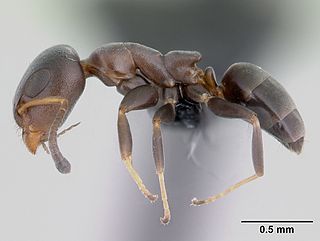
Dolichoderinae is a subfamily of ants, which includes species such as the Argentine ant, the erratic ant, the odorous house ant, and the cone ant. The subfamily presents a great diversity of species throughout the world, distributed in different biogeographic realms, from the Palearctic, Nearctic, Afrotropical region and Malaysia, to the Middle East, Australian, and Neotropical regions.

Doleromyrma is a genus of ants in the subfamily Dolichoderinae. The genus is native to Australia, where the ants nest in soil, or under stones or logs.

Iridomyrmex, or the rainbow ant is a genus of ant first described by Austrian entomologist Gustav Mayr in 1862. He placed it in the subfamily Dolichoderinae of the family Formicidae. There are 79 described species and five fossil species. Most of these ants are native to Australia; others are found in Asia and Oceania, and they have been introduced to Brazil, New Zealand and the United Arab Emirates. Fossil species are known from China, France and the United States.

Aphaenogaster is a genus of myrmicine ants. About 200 species have been described, including 18 fossil species. They occur worldwide except in South America south of Colombia, Sub-Saharan Africa, and Antarctica.

Anochetus is a genus of small, carnivorous ants found in the tropics and subtropics throughout the world.

Myrmecina is a genus of ants in the subfamily Myrmicinae. It contains 51 species distributed in North America, Europe, northern Africa, India east, Korea, Japan and Australia.

Dolichoderus is a genus of ants found worldwide.

Mesostruma is a genus of ants in the subfamily Myrmicinae. It is restricted to Australia.

Epopostruma is a genus of ants in the subfamily Myrmicinae. It is restricted to Australia.

Colobostruma is a genus of ants in the subfamily Myrmicinae. All except one species are restricted to Australia. The only non-Australian species, C. foliacea, is found in New Guinea and the Solomon Islands.

Nylanderia is a large genus of ants in the subfamily Formicinae. The genus has a nearly cosmopolitan distribution with species inhabiting a wide array of habitats in almost all geographic regions. Nylanderia, currently containing over 110 species, is an ecologically important genus, with some species reported as being invasive. The ants are small to medium in size and range in color from pale yellow to black.

Notoncus is an Australian genus of ants in the subfamily Formicinae. The genus is known from Australia, where the ants nest in the soil or on the ground under stones and logs in forested areas. The ants are also common in gardens and parks.

Mayriella is an Indo-Australian genus of ants in the subfamily Myrmicinae. Colonies in this genus are very small, typically consisting of 50 - 100 individuals.
Turneria arbusta is a species of ant in the genus Turneria. Described by Shattuck in 1990, the species is endemic to Papua New Guinea.

Turneria bidentata is a species of ant in the genus Turneria. Described by Forel in 1895, the species is endemic to Australia, mostly found in the north ends of the country.
Turneria collina is a species of ant in the genus Turneria. Described by Shattuck in 1990, the species is endemic to Papua New Guinea.
Turneriapostomma is a species of ant in the genus Turneria. Described by Shattuck in 1990, the species is endemic to Papua New Guinea.
Turneria dahlii is a species of ant in the genus Turneria. Described by Forel in 1901, the species is endemic to New Guinea, the Solomon Islands and Vanuatu.
Turneria frenchi is a species of ant in the genus Turneria. Described by Forel in 1911, it is endemic to Australia, but original specimens of the ant have been lost, and its placement in a genus has been in question. The ant has been transferred various times, notably being transferred to Stigmacros in 1990 but then put back into Turneria in 1992.














